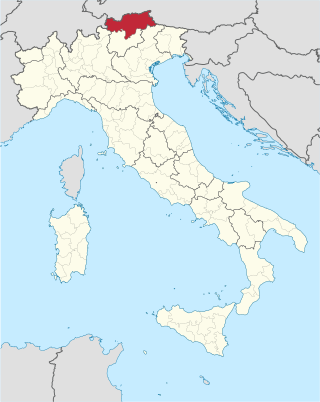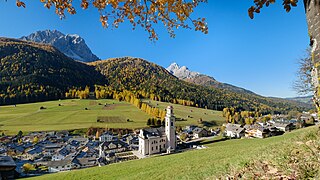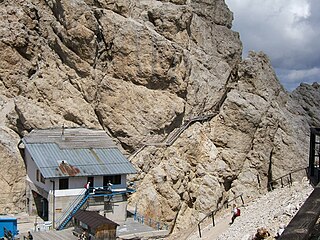
Schluderbach (Italian: Carbonin) is a settlement in the municipality of Toblach in South Tyrol, Italy, until 1918 part of the Austro-Hungarian County of Tyrol. It is largely a holiday village.

Schluderbach (Italian: Carbonin) is a settlement in the municipality of Toblach in South Tyrol, Italy, until 1918 part of the Austro-Hungarian County of Tyrol. It is largely a holiday village.
Schluderbach lies about 1,440 metres (4,720 ft) above sea level in the Höhlensteintal, a valley which forms an important route between Toblach and Cortina d'Ampezzo in the province of Belluno. Here the Popena Valley branches off to the south-east, in the direction of Lake Misurina. To the south is the Cristallo group of mountains, to the east is Monte Piana and the Three Peaks. The nearest village to the north is Höhlenstein, three kilometers to the west is the mountain pass Im Gemärk, at a height of 1,530 metres (5,020 ft).


At the beginning of the 19th century, when the locality was part of the Austro-Hungarian County of Tyrol, there was a timber trading post on the site of today's Schluderbach named in Italian Al Carbonin ("at the charcoal burner’s"), as charcoal burners worked there. A local farmer called Hans Ploner from Alt-Schluderbach (Carbonin Vecchia), a hamlet of Toblach near Niederdorf, opened an inn near this post called "Beim Schluderbacher", which gave the place its name. Hans Ploner's son Georg, called "Der Alte Schluderbacher", was able to establish the inn as an important base for the up-and-coming sport of mountaineering in the Dolomites. In 1872, he employed the brothers Hans and Michael Innerkofler as mountain guides. Other well-known alpinists of the time, such as Santo Siorpaes, led climbing tours from here, including many first ascents. Such well-known guides drew in rich climbing guests, and Schluderbach became the leading base for tours to the Three Peaks.
In 1874, Georg Ploner's daughter Anna was the first woman to reach the summit of the Great Peak, the highest of the Three Peaks, and Ploner himself was a mountaineer, in 1879 making the first ascent of the Western Peak. [1] [2]
The composer Gustav Mahler and his family spent much of the summer of 1907 at Schluderbach. [3]
During the First World War, Austria and Italy fought each other, and the international border between them then ran about one kilometre south-east of Schluderbach. The present-day border between the South Tyrol and the province of Belluno was roughly the front line in the White War fought between the two countries from 1915 to 1917. During that war, both sides built railways to support their war effort, the Italians building the Dolomites Railway as far as Toblach, which reached Schluderbach in 1917. [4] After the general Italian retreat of 1917, the whole line fell into the hands of the Austrians, but the situation was reversed at the end of the war, in November 1918, when this mostly German-speaking area was occupied by the Kingdom of Italy, and in 1919 it was annexed by Italy.
The Dolomites Railway was closed in 1962. [4]
Today Schluderbach has only a few houses, most of which are hotels and holiday homes, and is chiefly a holiday destination.

The Dolomites, also known as the Dolomite Mountains, Dolomite Alps or Dolomitic Alps, are a mountain range in northeastern Italy. They form part of the Southern Limestone Alps and extend from the River Adige in the west to the Piave Valley in the east. The northern and southern borders are defined by the Puster Valley and the Sugana Valley. The Dolomites are in the regions of Veneto, Trentino-Alto Adige/Südtirol and Friuli-Venezia Giulia, covering an area shared between the provinces of Belluno, Vicenza, Verona, Trentino, South Tyrol, Udine and Pordenone.

South Tyrol is an autonomous province in northern Italy. An English translation of the official German and Italian names could be the Autonomous Province of Bolzano – South Tyrol, reflecting the multilingualism and different naming conventions in the area. Together with the autonomous province of Trento, South Tyrol forms the autonomous region of Trentino-Alto Adige/Südtirol. The province is the northernmost of Italy, the second largest with an area of 7,400 square kilometres (2,857 sq mi), and has a total population of about 534,000 inhabitants as of 2021. Its capital and largest city is Bolzano.

Reinhold Andreas Messner is an Italian climber, explorer, and author from South Tyrol. He made the first solo ascent of Mount Everest and, along with Peter Habeler, the first ascent of Everest without supplemental oxygen. He was the first person to climb all 14 eight-thousanders, doing so without supplementary oxygen. Messner was the first to cross Antarctica and Greenland with neither snowmobiles nor dog sleds and also crossed the Gobi Desert alone. He is widely considered to be the greatest mountaineer of all time.

Cortina d'Ampezzo is a town and comune in the heart of the southern (Dolomitic) Alps in the province of Belluno, in the Veneto region of Northern Italy. Situated on the Boite river, in an alpine valley, it is an upscale summer and winter sport resort known for its skiing trails, scenery, accommodation, shops and après-ski scene, and for its jet set and Italian aristocratic crowd.

Sexten is a comune and a village in South Tyrol in northern Italy. The village is famous as a summer and winter sport resort in the mountains.

Ortler is, at 3,905 m (12,812 ft) above sea level, the highest mountain in the Eastern Alps outside the Bernina Range. It is the main peak of the Ortler Range. It is the highest point of the Southern Limestone Alps, of South Tyrol in Italy, of Tyrol overall, and, until 1919, of the Austrian-Hungarian empire. In German the mountain is commonly referred to as "König Ortler", like in the unofficial hymn of South Tyrol, the Bozner Bergsteigerlied.

Alta Via 1 is a 125-kilometre-long high-level public footpath which runs through the eastern Dolomites in Italy. It is also known as the Dolomite High Route 1. It passes through some of the finest scenery in the Dolomites. The path runs south from Pragser Wildsee, near Toblach, to Belluno. Prags can be accessed by bus, and Belluno has both train and bus services.

The Puster Valley is one of the largest longitudinal valleys in the Alps that runs in an east-west direction between Lienz in East Tyrol, Austria, and Mühlbach near Brixen in South Tyrol, Italy. The South Tyrolean municipalities of the Puster Valley constitute the Puster Valley district.

Toblach is a comune/Gemeinde (municipality) in South Tyrol in Northern Italy, located in the Puster Valley about 70 kilometres (43 mi) northeast of the city of Bolzano, on the border with Austria.

The Tre Cime di Lavaredo, also called the Drei Zinnen ; pronounced[ˌdʁaɪˈtsɪnən] ), are three distinctive battlement-like peaks, in the Sexten Dolomites of northeastern Italy. They are one of the best-known mountain groups in the Alps. The three peaks, from east to west, are:

The Dolomites Railway, originally the Ampezzaner Bahn or Ampezzaner Railway, was a railway in Northern Italy crossing the Dolomites mountains. The 64.9-kilometre (40.3-mile) long railway began in Calalzo and ended in Toblach. Its gauge was 950 mm — "Italian metre gauge". The Cortina d'Ampezzo - Toblach part was closed in 1962 and the Cortina d'Ampezzo - Calalzo di Cadore in 1964. Two EMUs went to the Trento - Malè railway and are still in use. Other vehicles went to the Ferrovie Appulo Lucane.

Tofane is a mountain group in the Dolomites of northern Italy, west of Cortina d'Ampezzo in the province of Belluno, Veneto. Most of the Tofane lie within the Ampezzo Dolomites Natural Park.

Cristallo is a mountain massif in the Italian Dolomites, northeast of Cortina d'Ampezzo, in the province of Belluno, Veneto, northern Italy. It is a long, indented ridge with four summits higher than 3,000 metres. The mountain range is part of the Ampezzo Dolomites Natural Park.

The Sentiero Ferrato Ivano Dibona is a challenging high alpine route along the Zurlon ridge, the main crest on Cristallo, a mountain group in the Italian Dolomites, northeast of Cortina d'Ampezzo, in the province of Belluno, Veneto, Italy. The use of a via ferrata set is recommended. The via ferrata is very well known because of the dolomitic scenery and the panoramic view.

The Sexten Dolomites is a mountain range and a nature reserve in South Tyrol, Italy. The nature park was renamed in 2010 to Parco Naturale Tre Cime.

Monte Pelmo is a mountain of the Dolomites, in the province of Belluno, Northeastern Italy.

Tofana di Rozes is a mountain of the Dolomites in the Province of Belluno, Veneto, Italy. Located west of the resort of Cortina d'Ampezzo, the mountain's giant three-edged pyramid shape and its vertical south face, above the Falzarego Pass, makes it the most popular peak in the Tofane group, and one of the most popular in the Dolomites.

Viktoria Savs served in the Austro-Hungarian Army during the First World War disguised as a man. She was one of two known female soldiers on the Austrian front lines. She served with the knowledge of her superiors, but virtually unrecognized as a woman, on the Dolomite front from 1915 to 1917. After a severe injury in May 1917, she was hospitalized, and her biological sex was discovered, ending her military career. She was awarded several medals for her dedication and bravery. She was known as the "Heroine of the Drei Zinnen."

The White War is the name given to the fighting in the high-altitude Alpine sector of the Italian front during the First World War, principally in the Dolomites, the Ortles-Cevedale Alps and the Adamello-Presanella Alps. More than two-thirds of this conflict zone lies at an altitude above 2,000m, rising to 3905m at Mount Ortler. In 1917 New York World correspondent E. Alexander Powell wrote: “On no front, not on the sun-scorched plains of Mesopotamia, nor in the frozen Mazurian marshes, nor in the blood-soaked mud of Flanders, does the fighting man lead so arduous an existence as up here on the roof of the world.”

Emma Hellenstainer was a pioneer of Tirolean Gastronomy. She exhibited formidable talents, both as a businesswoman and in terms of what, during the twentieth century, would have become widely understood as marketing.